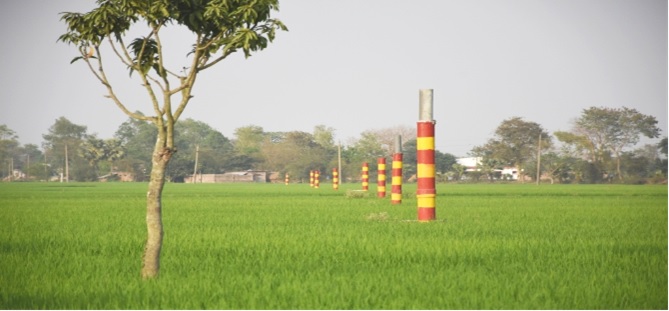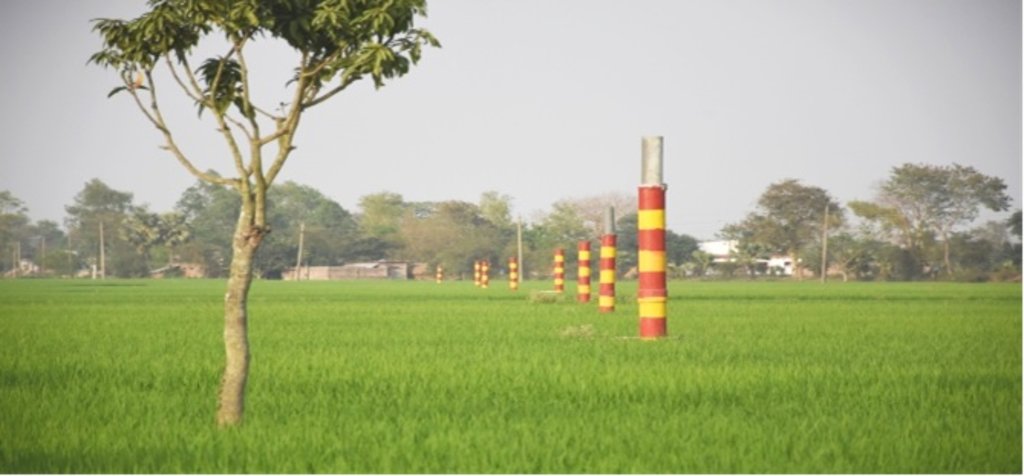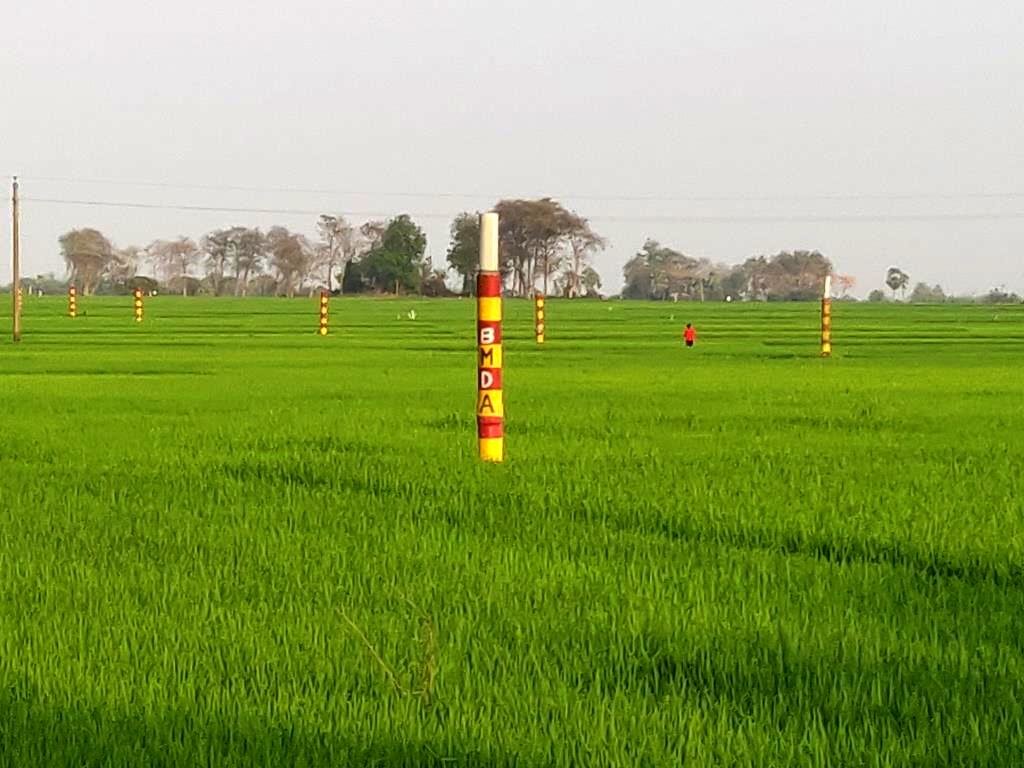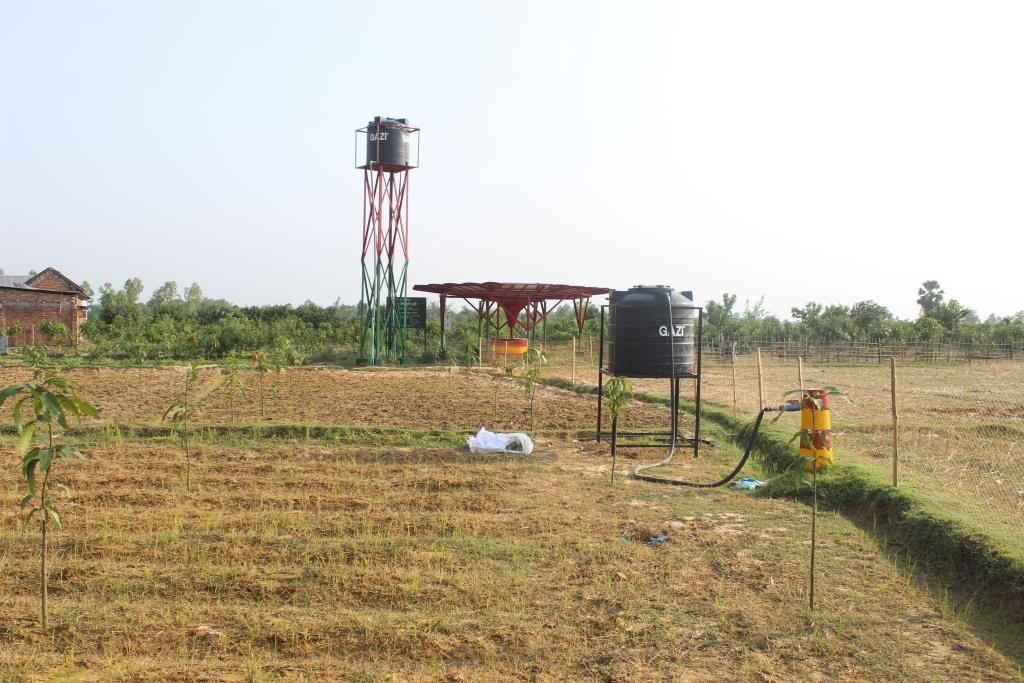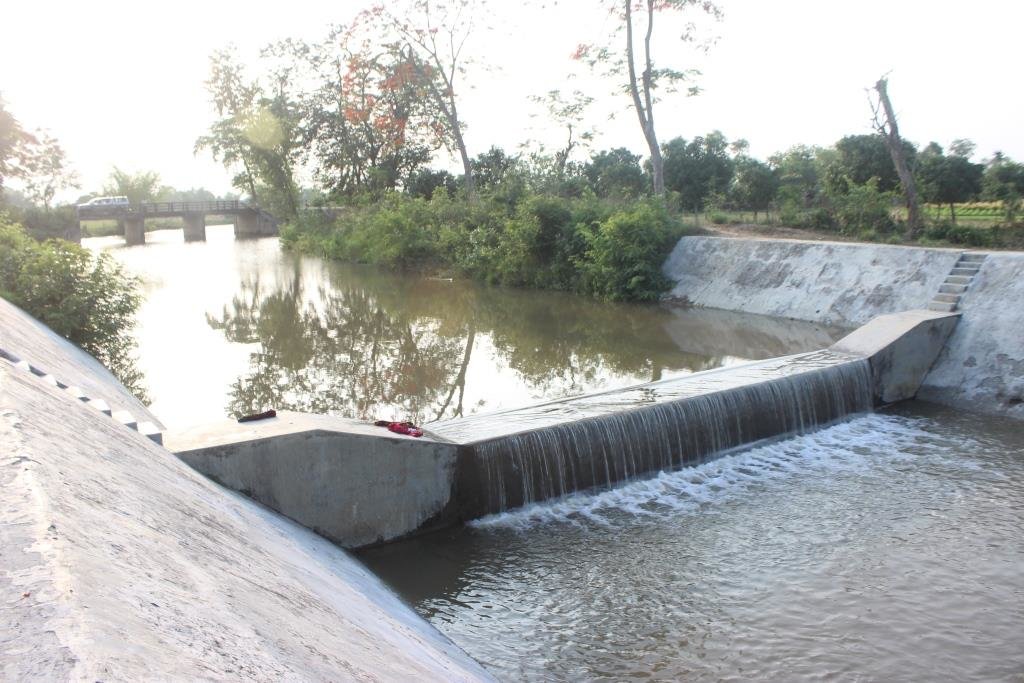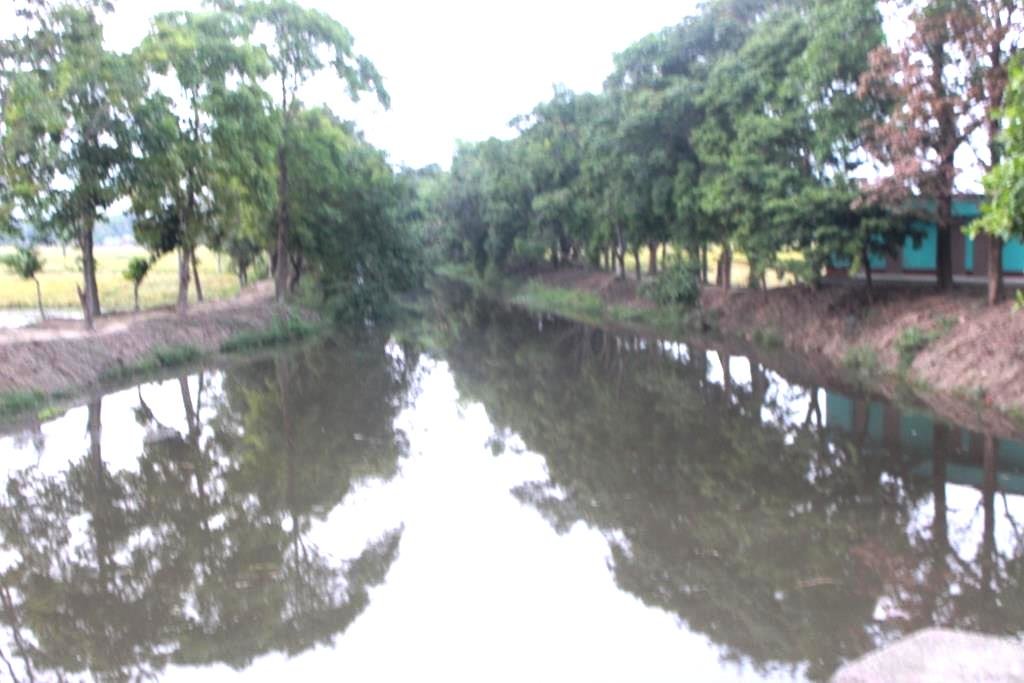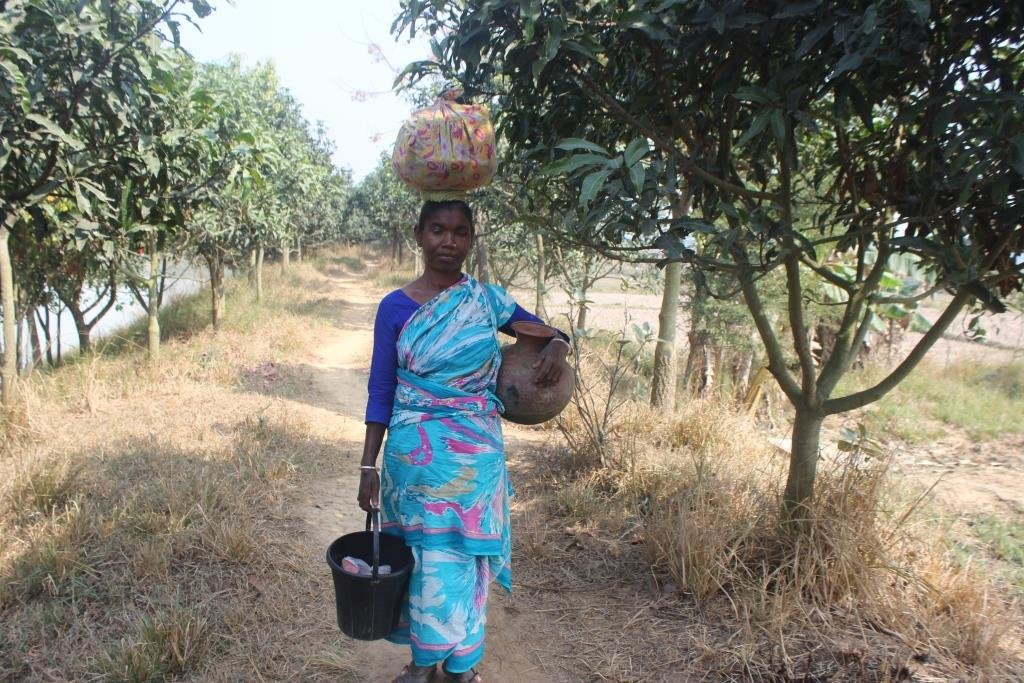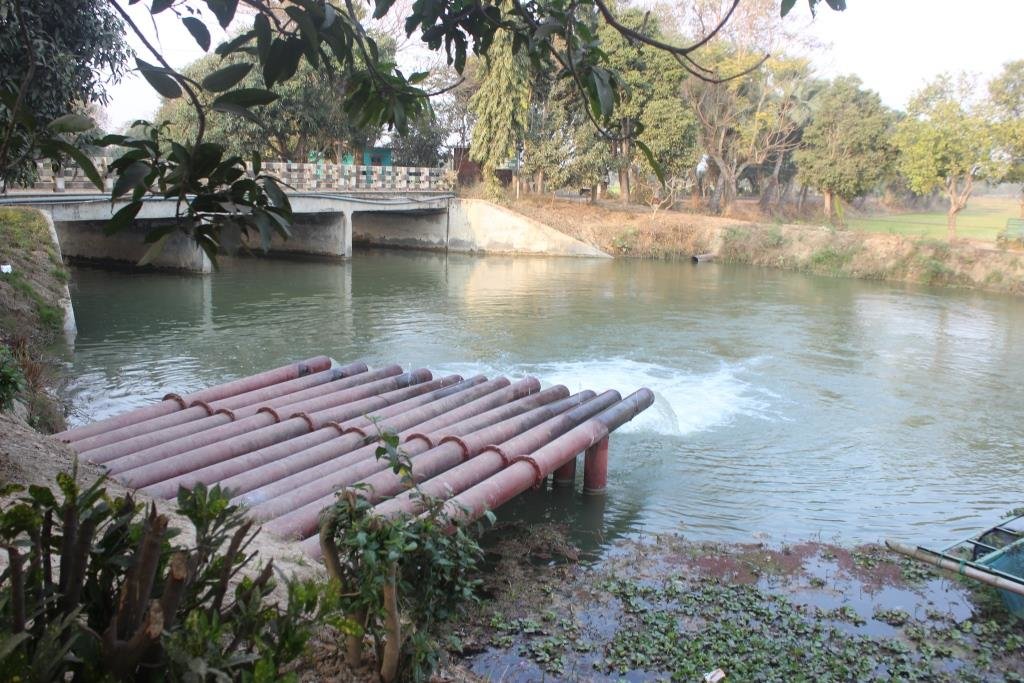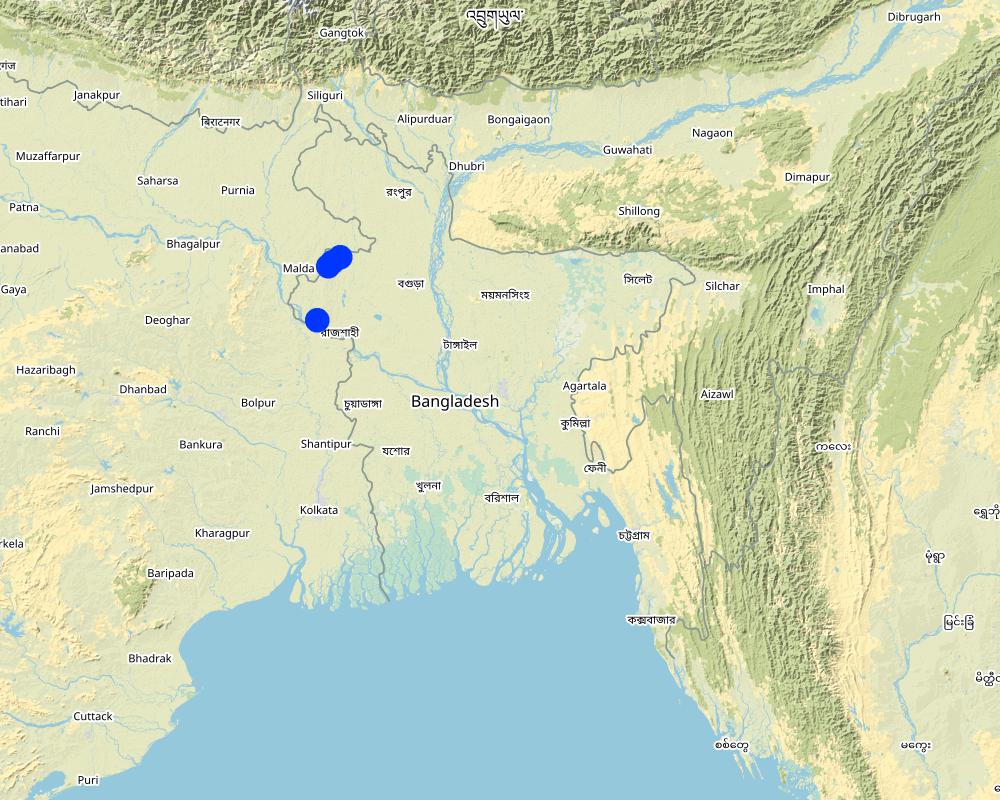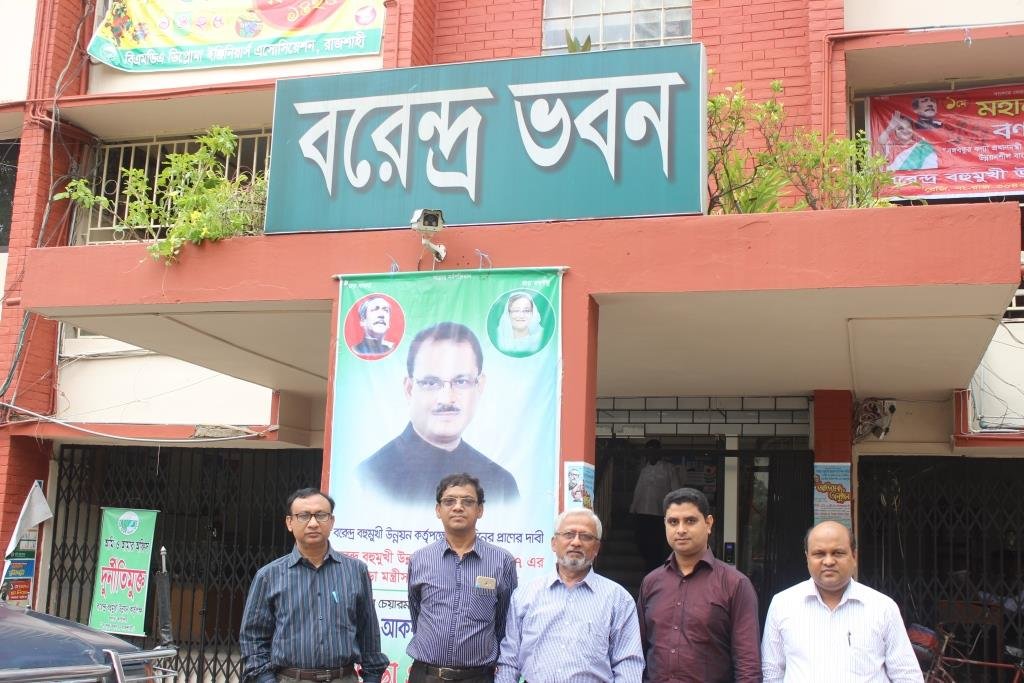Halting seasonal drought in Barind through efficient water resource management [Бангладеш]
- Создание:
- Обновить:
- Составитель: Jalal Uddin Md. Shoaib
- Редактор: –
- Рецензенты: William Critchley, Rima Mekdaschi Studer
Barendra elakay Khara proshaman
approaches_6143 - Бангладеш
Просмотреть разделы
Развернуть все Свернуть все1. Общая информация
1.2 Контактные данные специалистов и организаций, участвующих в описании и оценке Подхода
Название проекта, содействовавшего документированию/оценке Подхода (если применимо)
Establishing National Land Use and Land Degradation Profile toward Mainstreaming SLM Practices in Sector Policies (ENALULDEP/SLM)Название организации (-ий), содействовавших документированию/оценке Подхода (если применимо)
Department of Environment (DoE) - Бангладеш1.3 Условия, регламентирующие использование собранных ВОКАТ данных
Когда были собраны данные (на местах)?
08/04/2020
Составитель и ответственный/-ые специалист(-ы) согласны с условиями, регламентирующими использование собранных ВОКАТ данных:
Да
2. Описание Подхода УЗП
2.1 Краткое описание Подхода
Introduction of sustainable water usage to prevent impacts of seasonal droughts in Barind region, Bangladesh
2.2 Подробное описание Подхода
Подробное описание Подхода:
Barind is a drought-affected area of Bangladesh. It covers about 7,770 sq. km, that is 41% of the North Western part of Bangladesh, spreading over 16 districts of Rajshahi and Rangpur Division. It is one of the driest areas in Bangladesh with comparatively high temperatures - though cooler in the wet season from mid-June to October. Rainfall in the area varies from about 1500 mm to 2000 mm per annum. Temperature ranges from 4 degree Celsius to 44 degree Celsius. The area is at a comparatively higher elevation than the adjoining floodplains. There are two main terrace levels - one at 40m and the other between 19.8 and 22.9 m above mean sea level. The total cultivable area of Barind is about 583,000 ha, of which 34% is loamy, 10% is sandy, and 49% is clay: the remaining 7% is of other composition.
In the 1980s, the area was predominantly single cropped, and yields were poor and subject to seasonal drought, from late February to early May (up to the onset of pre-monsoon). No crops could be grown during the "rabi" season (November to May). The impacts of drought were severe and affected food insecurity and livelihoods. To address the situation, the Bangladesh Agricultural Development Corporation (BADC) under the Ministry of Agriculture (MoA) initiated two projects. One in 1985: The Barind Integrated Area Development Project and subsequently in 1992, the Barind Multipurpose Development Authority (BMDA) as a separate institutional entity. Both the projects focused on a new approach to water extraction, distribution and management practices at institutional level. Deep tubewells were installed and maintained by BMDA, rather than privately (which is often practiced in other parts of the country).
Deep tubewells (DTWs) were installed to abstract water from 15-20 meters, and water was initially distributed through open channels. Later, these were fitted with smart card–operated electric/solar pumps to develop a drought-resilient irrigation system Both projects have helped the Barind region reduce poverty and achieve self-sufficiency in rice. Without supplementary irrigation, there would be crop failure.
Since it was established, BMDA has focused on halting seasonal drought in Barind, and increased cropping intensity by providing irrigation through 15,800 DTWs in different districts. That reduced the cost of irrigation water for one bigha (0.1ha) from about $40 to <$20. On the other hand initiation of smart cards and buried pipelines for water distribution increased the efficiency of water use and facilitated revenue collection by the BMDA. However abstraction of groundwater (GW) for irrigation triggered another issue - drawdown of GW in the area, which even led to abandoning shallow tubewells (STW) used for drinking water.
In 2004 BMDA initiated another project, to lift surface water from the Padma river to ponds/canals/rivers in the main land after re-excavation. These sources are used as reservoirs and at the same time contribute to GW recharge generally. At the same time, usage of solar power instead of electricity is another means of reducing the cost of pumping water.
BMDA again installed 490 dugwells where STW or DTW could not be constructed. These dug wells are used for safe drinking water and small-scale irrigation. These measures have meant that, at present, the area avoids seasonal drought in most of the locations. Potatoes, "boro" and transplanted "aman" occupy more than 50% of the cultivable land. In addition, provision of safe drinking water and improved communications have boosted the local economy. The approach embraces various technologies including (1) tapping river water (from the Ganges, Mahananda and Tangan rivers0; (2) storing water in creeks or ponds; (3) distribution to farm land through subsurface irrigation pipes (buried pipelines); (4) use of low lift pumps (LLP) with solar energy support ; (5) prepaid water metering - usage of smart cards; (6) conversion of derelict water bodies to become effective water reservoirs ; (7) dug wells with solar power for water abstraction; (8) orchard plantations where both surface or groundwater are limited; (9) plantations of trees and horticultural crops along road and channels to change the land cover; (10) usage of compost to improve soil health. All of these contribute to land degradation neutrality (LDN) in one way or another.
Finally BMDA's approach is to boost productivity in the drought affected Barind through its projects, and encouraged communities to adopt diversified land use: previously much land remained fallow during most of the year outside the monsoon. Institutions like Department of Agricultural Extension (DAE) and many NGOs promote a variety of seasonal, annual and perennial crops in the area, the use of balanced fertilizer, plantation of high density fruit crops. The impact of the BMDA approach has greatly changed the drought-affected Barind.
2.3 Фотографии, иллюстрирующие Подход
Общие замечания к фотографиям:
All these pictures demonstrate the usage of surface water for irrigation and livelihoods in Barind.
2.5 Страна/ регион/ место, где применялся Подход
Страна:
Бангладеш
Административная единица (Район/Область):
Rajshahi
Комментарии:
Barind which was the driest area of Bangladesh, has now changed its landscape to green.
Map
×2.6 Даты начала и окончания реализации Подхода
Год начала реализации:
1992
Комментарии:
Barind Multipurpose Development Authority (BMDA) is continuing with more development projects to provide irrigation facilities with more options. Cropping intensity has increased, and most of the single cropped land has been transformed to double and triple cropped land.
2.7 Тип Подхода
- в рамках проекта/ программы
2.8 Каковы цели/ задачи Подхода
To provide irrigation water for cropping in dry season.
To increase cropping intensity in drought affected areas of Barind.
To manage land use or land cover in Barind.
To mobilize community on rational usage of soil and water resources.
2.9 Условия содействующие применению Технологии/ Технологий в рамках Подхода или затрудняющие его
Социальные/ культурные/ религиозные нормы и ценности
- содействуют
Increased livelihood options and access to education, marketing, health services.
Наличие/ доступность финансовых ресурсов и услуг
- содействуют
Increased access to financial institution.
Институциональные условия
- содействуют
All technical support provided by BMDA.
Сотрудничество/ координация действий
- содействуют
BMDA supports all action in related to irrigation, maintenance, water supply etc.
Нормативно-правовая база (землевладение, права на земле- и водопользование)
- содействуют
Lands owned by land users
Программные документы/ руководящие установки
- содействуют
Land users are in the line of BMDA policies.
Управление земельными ресурсами (принятие решений, осуществление и контроль за выполнением)
- содействуют
Traditional approach.
Осведомленность в области УЗП, доступность технической поддержки
- содействуют
Community has access to technical support.
Рынки (для приобретения материалов и услуг, продажи продукции) и цены
- содействуют
All inputs are available in the area.
Объем работ, доступность рабочей силы
- содействуют
Available, people are getting work now.
3. Участие и распределение ролей заинтересованных сторон
3.1 Заинтересованные стороны, участвующие в реализации Подхода и их роли
- местные землепользователи/ местные сообщества
Men and women are involved in the process
Growing crops as of their choice, for example: rice, fruits, vegetables or orchard trees.
- организации местных сообществ
Farmers have societies,
Influenced in choice of crops, etc.
- общественные организации
Several NGO s are functional in the area.
Most of them are supporting credit and marketing facilities
- местные власти
Local institutions involved in the process
Capacity building, advisory services on fertilizer usage, crop selection etc.
Если участвовало несколько заинтересованных сторон, назовите ведущую организацию:
BMDA is working as lead agency
3.2 Участие местных землепользователей/ местных сообществ на разных стадиях реализации Подхода
| Участие местных землепользователей/ местных сообществ | Перечислите участников и опишите их вовлеченность | |
|---|---|---|
| инициирование/ мотивация | пассивное | Farmers are using irrigation water for their crops supplied by BMDA and they pay revenue |
| планирование | пассивное | Farmer nor the community are involved in the planning process |
| выполнение | пассивное | Land users allow to set buried pipelines under their fields. |
| мониторинг/ оценка | пассивное | Land users are not involved in the M&E but they participate in the events organized. |
| нет | Land users only choose their crops to be grown |
3.3 Схема реализации (если имеется)
Описание:
Barind Multipurpose Development Authoroty (BMDA) is the symbol of development in Barind area also of the Tista fldooplain and the Old Himalayan piedmont plain.
Автор:
ShoaibJU
3.4 Принятие решений по выбору Технологии/ Технологий УЗП
Укажите, кто принимал решение по выбору применяемой Технологии/ Технологий:
- в основном землепользователи при поддержке специалистов по УЗП
Поясните на чём было основано принятие решений:
- анализ подробно описанного опыта и знаний по УЗП (принятие решений на основе подтвержденных фактов)
- результаты исследований
- личный опыт и мнения (незадокументированные)
4. Техническая поддержка, повышение компетенций и управление знаниями
4.1 Повышение компетенций/ обучение
Проводилось ли обучение землепользователей/ других заинтересованных лиц?
Да
Укажите, кто проходил обучение:
- землепользователи
- местный персонал/консультанты
Если существенно, укажите гендерный и возрастной состав, статус, этническую принадлежность и т.д.
BMDA has trained staff to care for the system by and large. There are both male and female staff.
Тип обучения:
- в ходе работы
- опытные участки
Рассматриваемые темы:
Buried pipeline maitenance, good seed production, marketing etc.
4.2 Консультационные услуги
Есть ли у землепользователей возможность получать консультации?
Да
Укажите, где именно оказываются консультационные услуги:
- в постоянно функционирующих центрах
Описание/ комментарий:
BMDA has field offices at each upazila to look after the system
4.3 Институциональная (организационная) поддержка
В ходе реализации Подхода были ли организованы новые институциональные структуры или поддержаны уже существующие?
- да, существенно
Укажите уровень, на котором структуры были укреплены или вновь созданы:
- местные
- региональный
Опишите организацию, функции и ответственность, членство и т.д.
BMDA has it headquarters at Rajshai city and sub-offices at all "upazila" to where the pipeline extended.
Укажите тип поддержки:
- повышение компетенций/ обучение
- оборудование
4.4 Мониторинг и оценка
Являются ли мониторинг и оценка частью Подхода?
Да
Комментарии:
BMDA monitors groundwater levels regularly, and also the pipelines and other operational activities.
Если да, будет ли данный документ использоваться для мониторинга и оценки?
Да
Комментарии:
During the documentation of the SLM best practices of the Banrind area intensive conversations, meetings and workshops were organized with all officials of headquarter and filed offices.
4.5 Научные исследования
Были ли научные исследования частью Подхода?
Нет
5. Финансирование и внешняя материальная поддержка
5.1 Годовой бюджет мероприятий по УЗП в рамках Подхода
Если точный годовой бюжет неизвестен, укажите примерный диапазон затрат:
- 10000-100000
5.2 Финансирование и внешняя материальная поддержка, предоставляемая землепользователям
Предоставлялась ли землепользователям финансовая/ материальная поддержка для применения Технологии /Технологий?
Да
Если да, укажите тип(-ы) поддержки, кто ее предоставил и условия предоставления:
All infrastructural establishment cost were born by BMDA
5.3 Субсидии на отдельные затраты (включая оплату труда)
- нет
- оборудование
| Укажите, какие ресурсы были субсидированы | В какой степени | Опишите субсидии подробнее |
|---|---|---|
| камень | профинансированы полностью | |
- строительные материалы
| Укажите, какие ресурсы были субсидированы | В какой степени | Опишите субсидии подробнее |
|---|---|---|
| дороги | профинансированы полностью | |
- инфраструктура
| Укажите, какие ресурсы были субсидированы | В какой степени | Опишите субсидии подробнее |
|---|
5.4 Кредитование
Предоставлялись ли в рамках Подхода кредиты на мероприятия УЗП?
Нет
5.5 Другие методы или инструменты стимулирования
Использовались ли другие методы или инструменты стимулирования для продвижения Технологий УЗП?
Да
Если да, поясните:
Installation and maintenance cost borne by BMDA, but farmers have to pay for water through smart cards (Pre-paid).
6. Анализ влияния и заключительные положения
6.1 Влияние Подхода
Сумел ли Подход расширить возможности местных землепользователей, повысить участие заинтересованных сторон?
- Нет
- Да, немного
- Да, умеренно
- Да, существенно
Farmers are using irrigation water for their crops
Сумел ли Подход дать возможность принимать решения на основе подтвержденных фактов?
- Нет
- Да, немного
- Да, умеренно
- Да, существенно
As of now buried pipe lines for irrigation water supply are being adopting in many areas of the country.
Сумел ли Подход помочь землепользователям внедрить и поддерживать технологии УЗП?
- Нет
- Да, немного
- Да, умеренно
- Да, существенно
Usage of water rationally: BMDA installs control meters for each of the land user.
Сумел ли Подход улучшить согласованность действий и повысить рентабельность применения практик УЗП:
- Нет
- Да, немного
- Да, умеренно
- Да, существенно
The approach had changed the Barind ecosystem at large.
Сумел ли Подход расширить знания и возможности землепользователей в применении практик УЗП?
- Нет
- Да, немного
- Да, умеренно
- Да, существенно
Land users enable to use irrigation water for growing crops of their choice
Сумел ли Подход расширить знания и возможности других заинтересованных сторон?
- Нет
- Да, немного
- Да, умеренно
- Да, существенно
Other local institutions in Barind area are involved in the system.
Сумел ли Подход укрепить сотрудничество между заинтересоваными сторонами/ выстроить механизмы сотрудничества?
- Нет
- Да, немного
- Да, умеренно
- Да, существенно
Adoption of the irrigation system at all areas of the Barind.
Сумел ли Подход снизить остроту конфликтов?
- Нет
- Да, немного
- Да, умеренно
- Да, существенно
Stakeholders are enable to use water as they like.
Сумел ли Подход расширить возможности социально и экономически уязвимых групп?
- Нет
- Да, немного
- Да, умеренно
- Да, существенно
The area was resource poor before the 1990s. Now livelihoods of the community improved largely.
Сумел ли Подход содействать гендерному равенству и расширить права и возможности женщин и девочек?
- Нет
- Да, немного
- Да, умеренно
- Да, существенно
Man and women are engaged themselves in their land and crops.
Сумел ли Подход стимулировать молодежь/ будущее поколение землепользователей заниматься УЗП?
- Нет
- Да, немного
- Да, умеренно
- Да, существенно
Interventions with new crops, specially high value fruits etc in the area.
Сумел ли Подход разрешить правовые проблемы землевладения/ землепользования, препятствующие использованию технологий УЗП?
- Нет
- Да, немного
- Да, умеренно
- Да, существенно
Land tenure system is traditional, where large areas are sublet or leased to the individuals or groups by the land owners.
Сумел ли Подход способствовать улучшению продовольственой безопасности/ качества питания?
- Нет
- Да, немного
- Да, умеренно
- Да, существенно
The area produces a large amount of cereals, potatoes, vegetables, fruits etc.
Сумел ли Подход расширить доступ к рынкам?
- Нет
- Да, немного
- Да, умеренно
- Да, существенно
Fruits and paddy rice have good markets.
Сумел ли Подход улучшить санитарные условия и доступ к водоснабжению?
- Нет
- Да, немного
- Да, умеренно
- Да, существенно
Safe drinking water where tubewells do not function, and sanitation also developed as the system.
Сумел ли Подход привести к более эффективному использованию электроэнергии/ возобновляемых источников энергии?
- Нет
- Да, немного
- Да, умеренно
- Да, существенно
Using solar power to abstract dug well water greatly facilitates the community.
Сумел ли Подход улучшить способность землепользователей адаптироваться к изменениям климата и смягчать последствия катастрофических погодных явлений?
- Нет
- Да, немного
- Да, умеренно
- Да, существенно
Vegetative cover in the Barind has changed the ecosystem at large.
Сумел ли Подход привести к созданию новых рабочих мест/ к расширению возможностей получения дохода?
- Нет
- Да, немного
- Да, умеренно
- Да, существенно
Local people are having work everywhere of the Barind.
6.2 Основные причины, побуждающие землепользователей внедрять УЗП
- рост продуктивности
Cropping intensity increased
- рост прибыли (доходности) и рентабельности
Low cost of irrigation water contributes to benefits for the land users.
- снижение деградации земель
Halts or reduces seasonal drought
- снижение риска катастрофических погодных явлений
Less climate extremes, no crop loss due to drought. Temperature relatively cooler than before.
- нормативно-правовое регулирование (штрафы)/ контроль
No social unrest
- престиж, общественное давление/ солидарность
Livehood improved greatly.
- экологическая сознательность
Local people are now aware of the environment. They grow trees around their homesteads, preserve water in their ponds etc.
6.3 Долгосрочная устойчивость мероприятий в рамках Подхода
Могут ли землепользователи самостоятельно (без внешней поддержки) продолжать применение того, что было реализовано в рамках Подхода?
- да
Если да, опишите как:
Buried pipeline irrigation has changed the Barind area greatly.
6.4 Сильные стороны/ преимущества Подхода
| Сильные стороны/ преимущества/ возможности по мнению землепользователей |
|---|
| More crops could be grown throughout the year, |
| Crop diversity is possible, annual, perenial or seasonal |
| Secure crop production |
| Сильные стороны/ преимущества/ возможности по мнению составителя или других ключевых специалистов |
|---|
| Minimum loss of irrigation water |
| Surface (river) water usage minimize stress on ground water usage |
| Improved ground water recharge |
| Safe drinking water where tubewell is not available. |
| Usage of solar power for lifting water from dug well or for lifting water to buried pipeline |
| Introduction of water meters reduces misuse of irrigation water |
6.5 Слабые стороны/ недостатки Подхода и пути их преодоления
| Слабые стороны/ недостатки/ риски по мнению землепользователей | Возможные пути их преодоления/снижения? |
|---|---|
| The system could be implemented at single farmer level | Developing community approach with the support of the government |
| Слабые стороны/ недостатки/ риски по мнению составителя или ответственных специалистов | Возможные пути их преодоления/снижения? |
|---|---|
| Very high pressure on land and soil resources | Lower water consumptive crops could be introduced |
| Severe soil nutrient depletion may develop | Use of manure/ compost or organic matter or crop rotation to enrich soil |
7. Справочные материалы и ссылки
7.1 Методы сбора/источники информации
- выезды на места, полевые обследования
Intensive field visit with responsible officers (5) from BMDA and interview with beneficiaries (30) .
- опросы землепользователей
Especially the farmers (5) who used to grow very high density fruits crops and of solar powered dugwell (3)
- опросы специалистов/экспертов по УЗП
10 officers from different institutions, like BMDA, DAE, University of Rajshahi, SRDI, NGO, Fishries etc.
- данные, собранные из отчетов и достоверных документов
Few official docments of design and plan of pipelines, dugwell etc.
7.3 Ссылки на материалы, доступные онлайн
Название/ описание:
Baring Multipupose Development Authority
Адрес в сети Интернет:
http://www.bmda.gov.bd/site/page/2ea693ba-ac10-4ada-b304-111d72a72105/-#
Название/ описание:
Pro-Poor Groundwater Development
Адрес в сети Интернет:
https://openknowledge.worldbank.org/bitstream/handle/10986/33246/Pro-Poor-Groundwater-Development-The-Case-of-the-Barind-Experiment-in-Bangladesh.pdf?sequence=5
Ссылки и модули
Развернуть все Свернуть всеСсылки
Нет ссылок
Модули
Нет модулей


